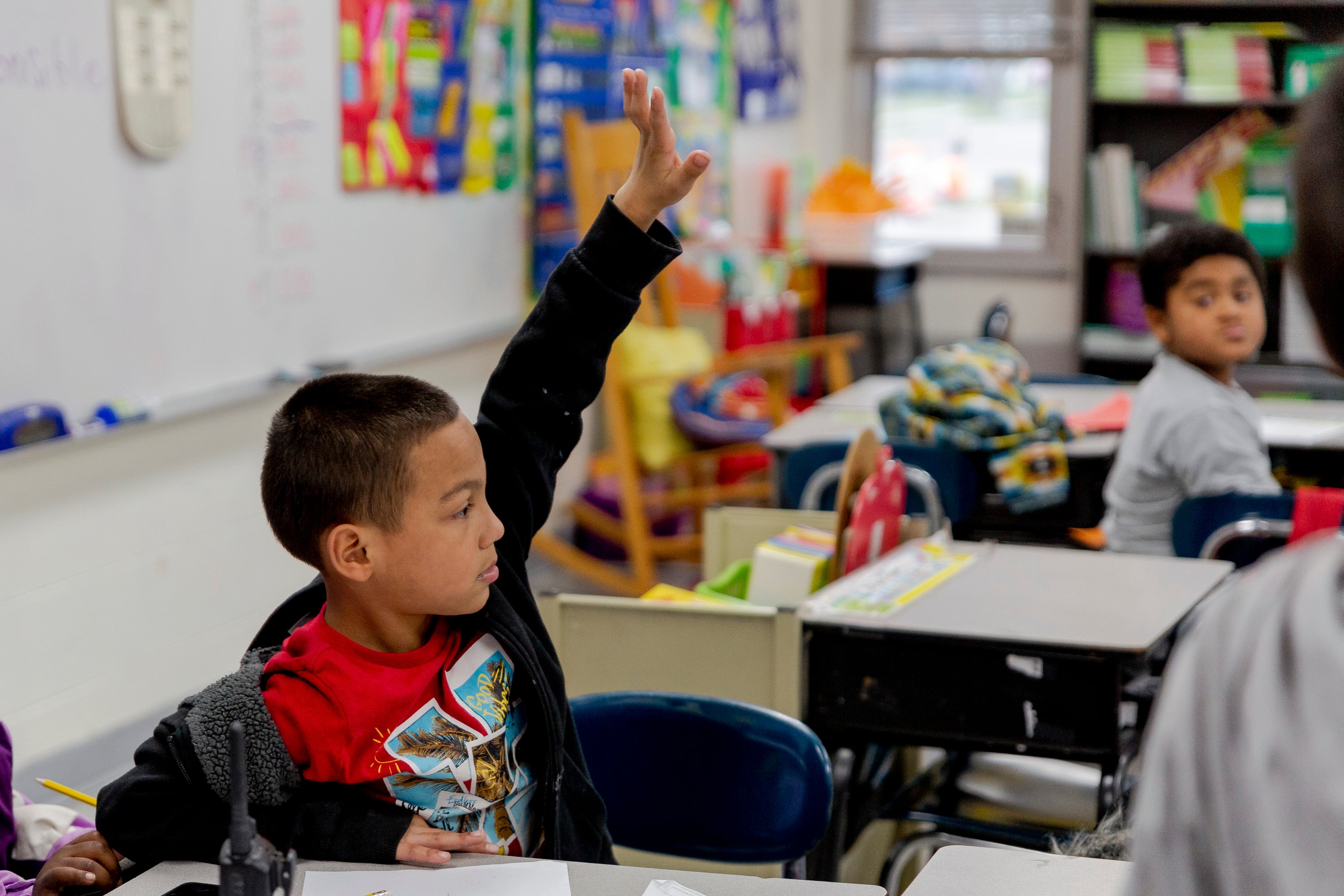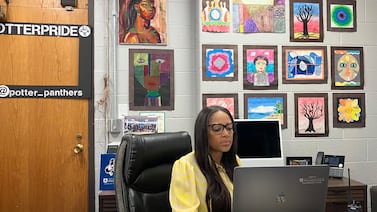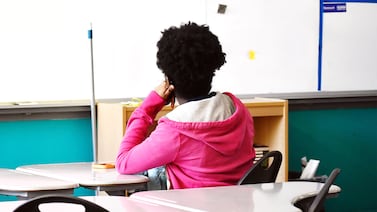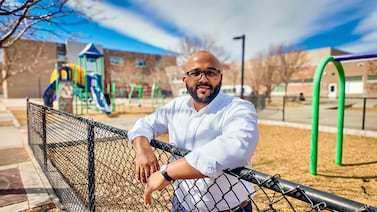Grand Rapids Public Schools received $104 million in federal COVID-19 relief funding, an enormous one-time cash infusion equal to about half its annual budget.
The district used the money for tutoring, extra summer programs, and coaching for teachers. But now, facing an uncertain economy and the expiration date of the federal funds, the district is shifting its focus from spending to saving.
“Yes, we have a lot of money right now, but it is one-time money,” said Rhonda Kribs, chief financial officer of Grand Rapids Public Schools. “We’re on a cliff, so we need to be planning for what the district looks like in two years.”
That’s not quite what federal policymakers had in mind when they sent $6.2 billion in COVID relief funding to bolster Michigan’s education system. They wanted districts to spend the money on urgent needs like addressing the academic and emotional toll of the pandemic, which is why they set a fall 2024 deadline for the last of the spending.
Districts have already spent $1.6 billion of the federal aid to support students and shore up crumbling school infrastructure, and they’ve laid plans to spend billions more. Loose federal guidelines allow districts to use their aid to help build up savings, said Tom DeKeyser, superintendent of Whitmore Lake Public Schools. “But the needs of the students are so great.”
Yet Grand Rapids and many other districts are calculating that it’s just as critical to bolster their reserves while they can, and protect against future funding cuts that could destabilize children’s education again. They’re heeding warnings from school finance experts of a “perfect storm” of economic uncertainty fueled by inflation, enrollment declines, the threat of recession, and expiring federal aid.
“This year and probably the next school year look pretty healthy. But the medium term looks a lot scarier,” said Chad Aldeman, policy director of the Edunomics Lab, a nonpartisan think tank based at Georgetown University, adding: “How do we make investments that respond to the needs of today without putting districts in a hole in a few short years?”
How districts choose to allocate their resources during this unusual period of plenty could play a big role in determining how successfully they can support students through the profound challenges left by the pandemic, and whether they’re able to get through future fiscal crises without a new round of disruption.
For some administrators who witnessed painful cuts after the Great Recession, it’s a no-brainer to put away some money while school budgets are at a historic highwater mark.
“I’ve lived through two times when the state cut school funding,” Lou Steigerwald, superintendent of Norway Vulcan Area Schools in Michigan’s Upper Peninsula, said in an email. “Schools with no or little (fund balance) had to borrow money and slash staff and other items in their budgets.”
Indeed, Michigan’s most financially troubled districts, which were battered by the Great Recession, have been able to wipe out deficits and bolster their fund balances during the pandemic, allowing them to exit state oversight.
In a time of enormous academic needs, though, the tilt toward savings has some people worried that students will be shortchanged. For parents of students who struggled with virtual learning and other pandemic-related disruptions, it can be hard to accept anything but an aggressive spending plan from school districts.
“I have a kid who’s struggling, so it’s frustrating,” said Heidi Gates, parent of two children at Brighton Area Schools, where the fund balance jumped from $8 million pre-pandemic to a projected $14.7 million this year. “I feel like schools are saying, ‘OK, we’re back to normal.’”
Others warn that this caution could feed a public perception that districts are sitting on federal dollars meant for students — a perception that could come back to haunt the school system in coming funding fights.
“The school rescue funds were designed to help students now,” said Thomas Morgan, a spokesman for the Michigan Education Association, the state’s largest teachers union. “For that to happen, the money needs to be spent, and not sit in the bank. I know administrators will say they’re saving money for a rainy day, but it’s raining now.”
Savings on the rise
School funding experts often use fund balances — sometimes called reserves or a “rainy day fund” — as a proxy for districts’ financial health. In broad terms, a district’s fund balance is what’s left over after a district has done all of its spending for the year.
A large fund balance functions as a cushion in the event of funding cuts or an unexpected problem with a school building. Districts with small fund balances typically face higher costs to borrow through the bond market. A negative fund balance — which means a district can’t cover its bills for the year — triggers state oversight, and can eventually lead to districts being shuttered or taken over by the state.
After one year of the pandemic, fund balances across Michigan school districts skyrocketed.
By summer 2021, when the most recent audited school finance data was released, the combined reserves of Michigan school districts had grown by 37%, from $2.4 billion pre-pandemic to $3.3 billion, according to the Citizens Research Council of Michigan, a nonpartisan think tank.
Michigan school leaders are counseled to maintain fund balances equal to 15% to 20% of their expenditures. Last year, for the first time in at least a decade, more than half of districts had fund balance ratios of more than 20%. The number of districts above that threshold rose to 438 from 263, a two-thirds increase.
“Schools are as flush as they’ve ever been in history,” said Craig Thiel, research director for the CRC.
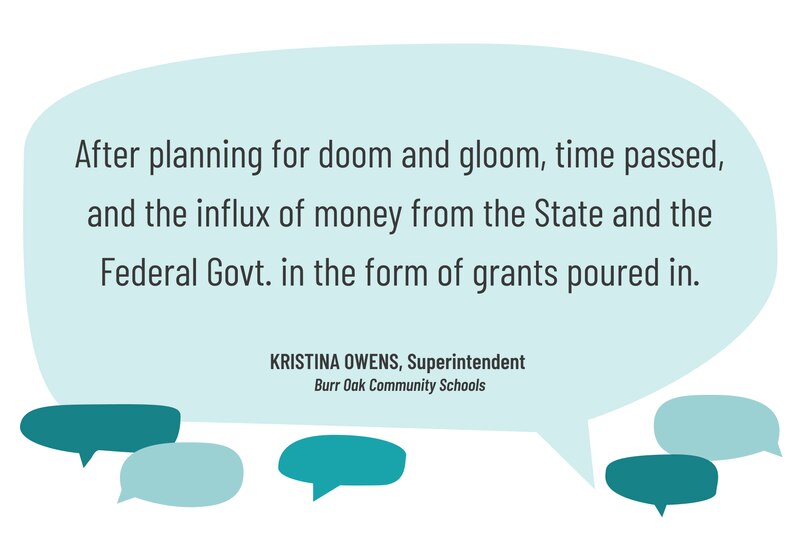
Superintendents pointed to numerous reasons that reserves increased. Virtual learning brought savings on school bus fuel and heating. At the same time, the state sharply increased per pupil funding and changed its funding policies to help districts with declining enrollment.
Others emphasized that reserves were boosted by transitory pandemic-related factors like school shutdowns and supply chain disruptions. In Grand Rapids, for example, Kribs said that supply chain issues forced the district to delay purchasing new security vehicles, inflating the district’s fund balance.
The most widely cited explanation, however, was the $6.2 billion in federal COVID aid that is being sent directly to school districts to help them deal with the effects of the pandemic.
In interviews and survey responses, 21 Michigan superintendents — echoing their counterparts nationwide — said it has been difficult to spend the extra funds. A tight labor market has slowed hiring, and many superintendents were reluctant in any case to expand their staffs using funds that will expire within a few years.
Some said the increased fund balances are only temporary while districts save for major expenses that are coming up soon, such as school renovations. Still, many argued that putting some money away now is just good policy given the risks they face in the next two years from inflation, declining enrollment, and the expiration of the federal relief dollars.
The state school budget reached record highs this year, but superintendents worry that a recession could reverse that trend. And even if the state budget remains strong, many districts will still see their revenues fall sharply, particularly those in high-poverty areas that received the most federal aid. For instance, the Lansing School District is in line to receive about $10 million extra under the latest state budget, but it received $142 million in federal aid.
“Fund balance allows for the consistency of programming in good times and bad,” said Robert Dwan, deputy executive director of Michigan School Business Officials, a trade association that provides financial training and support to district officials.
“Having a healthy fund balance which may help support the district in poor economic times helps fulfill the district’s responsibility to ensure today’s kindergartener graduates with as little disruption as possible throughout their educational journey,” Dwan added.
Flash in the pan or long-term plan?
It’s important to note that districts are not simply depositing their federal aid in the bank.
Under the laws governing that aid, that money is supposed to go exclusively to COVID-19 relief and can’t be channeled directly into reserves. But broad spending guidelines for the funds meant districts were able to apply the federal aid to some of their normal operating costs — things like laptop computers, building repairs, and some teacher salaries — and then direct some of the unspent operating funds into savings.
While available data don’t show how much districts spent on new programs, it’s clear that many schools upped their summer school offerings, expanded mental health services, and trained teachers and bought new curriculums to support students’ academic recovery.
With the federal funds expiring, district leaders said there’s a real danger that overspending now could make matters worse for students and teachers if their districts ended up in a budget hole in a few years.
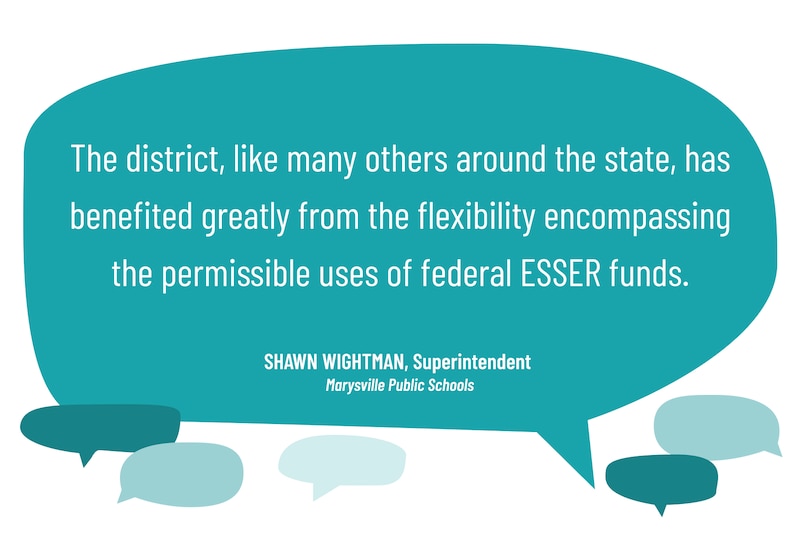
“It’s a fine line, because this money was meant to accelerate learning that was disrupted due to COVID, but at the same time, if you’re able to build a fund balance, then I could see districts doing that,” said Nathan Kalasho, director of Keys Grace Academy, a charter school in suburban Detroit.
Still, some superintendents pushed back on the notion that districts’ long-term financial health changed significantly during the pandemic, arguing that district reserves will drop back to normal levels when federal COVID-19 relief expires in 2024.
“The growth of our fund balance is temporary and directly correlates with the one-time federal funding that must be spent by specific deadlines,” said C. Martin James, superintendent of Central Montcalm Public Schools, a rural district in central Michigan.
Indeed, some districts have already laid plans to spend down their reserves within a few years. Consider the Detroit Public Schools Community District, where the fund balance is projected to skyrocket from $101 million in 2021 to $788 million in 2024. Most of that additional money — $700 million — will then be used to fund a long overdue overhaul of the districts’ school buildings.
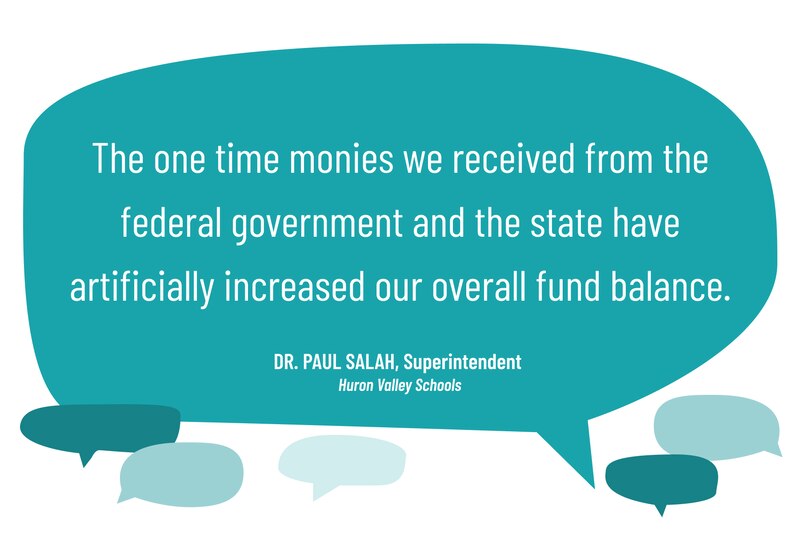
Whitmore Lake is in ‘spending mode’
In the suburbs north of Ann Arbor, Whitmore Lake Public Schools has been spending aggressively on a coaching program for teachers and additional classroom aides to help offset the academic impacts of the pandemic. While the district’s fund balance rose thanks to federal COVID-19 relief, the district is still operating in “spending mode,” said DeKeyser, the superintendent.
Behind that spending, said DeKeyser, is a bet that the district can find a way to shore up its finances later on when the federal money dries up.
Years ago, Whitmore Lake made a similar bet — and lost. During the Great Recession, when he was an assistant superintendent, DeKeyser watched Whitmore Lake spend down its federal relief funds in anticipation of additional support from the state or the federal government. But the additional help didn’t come.
“In 2009 we got to the end of our [stimulus] funds and it was like ‘Oh, what do we do now?’” he said.
This time, the answer for Whitmore Lake is retirements. DeKeyser says he’s anticipating staff turnover of about 50% over the next four years. By not filling some positions, he hopes to downsize the district’s budget enough to keep its finances stable after the federal aid expires.
But he knows there are no guarantees for his district and others statewide.
“If we maintain this spending, things could get catastrophic,” he said. “Any time you get a federal boost like this, you can look good in the short term. But it’s how you look four years out that defines how well you’re managing your funds.”
Koby Levin is a reporter for Chalkbeat Detroit covering K-12 schools and early childhood education. Contact Koby at klevin@chalkbeat.org.

